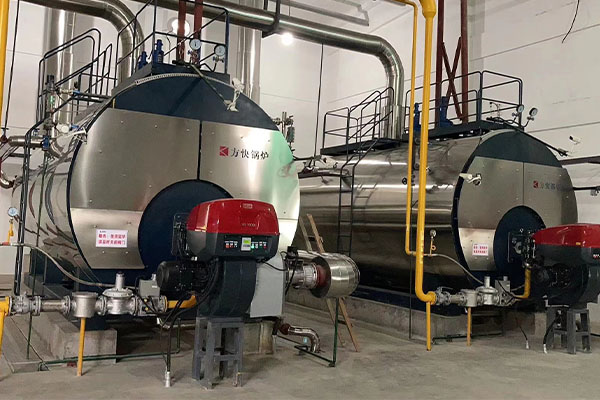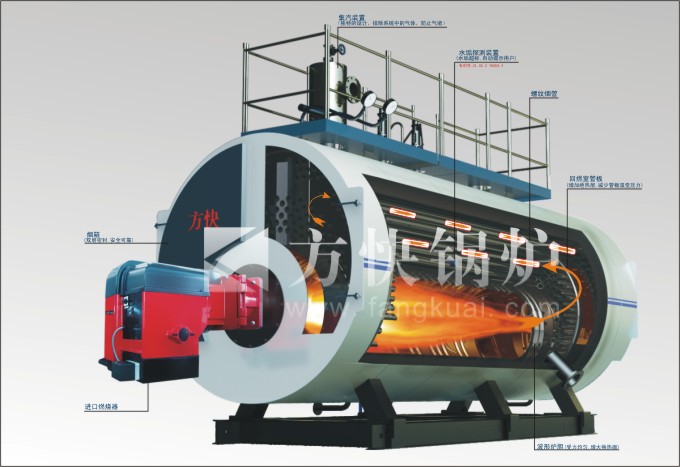Taking a 10 ton/hour (≈10tph) steam boiler as an example, a comprehensive comparison is made between oil-fired steam boilers and natural gas-fired steam boilers.
1. Steam Boiler Working Principles
-
Oil‑fired steam boiler
Fuel oil is pressurized and atomized through a nozzle in the burner, creating a fine mist that mixes with combustion air and ignites in the furnace. Hot flue gases then pass through fire‑tubes (or water‑tubes) transferring heat to boiler water, generating steam. -
Gas‑fired steam boiler
Natural gas is metered and premixed with combustion air (in a forced‑draft burner) before ignition. The resulting flame heats the boiler’s heat‑exchange surfaces, producing steam. Turndown ratios of 5:1–10:1 allow modulation of firing rate for matching load.
2. Investment Cost Analysis
| Item | Oil‑fired Steam Boiler | Gas‑fired Steam Boiler |
|---|---|---|
| Equipment price | Base boiler plus oil‑pump and storage fittings | Base boiler plus gas train (regulator, meter, safety shutoff) |
| Relative cost | Generally baseline | 5–10 % higher or similar, depending on burner model and gas‑train complexity. In many regions, gas units of equal capacity cost slightly less due to simpler burner design. |
Note: Riello condensing models offer up to 98 % efficiency on gas and are available with dual‑fuel options, but carry a premium over non‑condensing units.
3. Installation Cost Analysis

-
FangKuai Oil Steam Boiler
Requires on‑site fuel storage (tank, leak containment), diesel piping and filtration. Flue system may need corrosion‑resistant lining if high‑sulfur oil is used. -
FangKuai Gas Steam Boiler
Involves tying into the municipal gas main, installing a pressure‑reducing station, and gas‑safety interlocks. No storage tank or oil filtration is needed.
Typical comparison: installation of an oil‑fired boiler can be 15–25 % more expensive than a gas boiler of the same capacity, owing to the extra civil works and environmental controls for the fuel‑oil system.
4. Operating Cost & Thermal Efficiency
| Metric | Oil‑fired Steam Boiler | Gas‑fired Steam Boiler |
|---|---|---|
| Nominal thermal efficiency | 88 – 92 % | 90 – 95 % (condensing up to 98 %) |
| Fuel cost basis | ||
| (per MMBtu, delivered) | $24.86/MMBtu at 87 % AFUE | $13.16/MMBtu at 95 % AFUE |
| Cost to produce 1 ton (2,000 lb) steam (≈2.26 GJ or 2.14 MMBtu) |
≈2.14 × $24.86 ≈ $53.2/ton steam | ≈2.14 × $13.16 ≈ $28.2/ton steam |
Conclusion: gas steam boilers typically halve fuel costs compared to oil at these efficiency and fuel‐price levels.
5. Emission Comparison
| Pollutant | Oil‑fired Steam Boiler | Gas‑fired Steam Boiler |
|---|---|---|
| SO₂ | Significant, unless ultra‑low‑sulfur oil is used | Negligible |
| NOₓ | Moderate; controlled by low‑NOₓ burners or FGR systems | Generally lower due to cooler flame and premix design |
| Particulate matter | 0.0027 lbs/MMBtu | 0.0030 lbs/MMBtu (virtually no soot) |
| CO & unburned hydrocarbons | Risk of incomplete combustion if poorly tuned | Very low with proper burner control |
Data sourced from fuel‐characteristics studies and burner tests.
6. Safety Factor Comparison
-
Oil‑fired systems
-
Risks: fuel‑oil leaks (fire hazard), pump‑failure releases, soot buildup
-
Protections: flame detectors, leak pans, automatic shutdown on flame loss
-
-
Gas‑fired systems
-
Risks: natural gas leaks (explosion hazard), flashback, CO poisoning
-
Protections: gas‑leak detectors, excess‑air interlocks, redundant safety shutoff valves
-
Both systems adhere to ASME and local codes; overall incident rates are low when properly maintained.
7. Usage Scenarios & Selection Suggestions
-
Remote or no‑gas‑line sites
Choose oil‑fired boiler—diesel (or bio‑blend) storage ensures fuel availability. -
Urban or industrial parks with reliable gas supply
Choose gas‑fired boiler for lower fuel/maintenance costs and cleaner emissions. -
High‑efficiency, low‑emission requirement
Opt for a condensing gas boiler (Riello RTC series up to 98 % efficiency). -
Backup or dual‑fuel operation
Consider dual‑fuel Riello burners capable of switching between oil and gas seamlessly.

8. Conclusion
For a 10 tph steam application with Riello burners:
-
Capital investment is roughly on par, with gas boilers slightly favored in competitive markets.
-
Installation is simpler and typically ~15 % cheaper for gas, given no oil‑tank groundwork.
-
Operating costs for gas are about 50 % lower at current fuel prices and efficiencies.
-
Emissions from gas are substantially cleaner (virtually zero SO₂/particulates).
-
Safety profiles differ but are equivalent under proper controls.
-
Recommendation: where pipeline gas is accessible, a modern condensing gas steam boiler offers the best lifecycle cost and environmental performance. In off‑grid or backup‑critical sites, oil‑fired steam boilers remain a robust choice.
We are a Class A boiler manufacturer in China, providing you with free services in boiler selection, boiler room design, etc.
Get your best price
Quickly compare 3 FREE quotes
- Engineer quick quote
- The overall delivery speed is fast
- Financial choice
- Low installation costs and cost savings
25 years+ of boiler R&D
More than 20 innovative technologies


